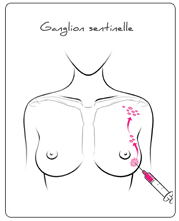Breast surgery
Adnexa surgery
Uterine surgery
Cervical surgery
Vulvar surgery
Other
Axillary lymph node dissection & sentinel lymph node dissection
Axillary Lymph Node Dissection (ALND)

ALND is a surgery procedure to withdraw part of nodes of the armpit. This is done only for breast cancer, as breast cancerous cells use lymph channels to spread from to the breast to the armpit and then the whole body.
Incision is performed over the armpit. A redon’s drain is installed to collect fluids (blood and lymph fluids). Analysis of the withdrawn nodes will allow knowing whether cancerous cells have spread on this area. According to this analysis, a complementary treatment may be proposed: chemotherapy and / or hormone therapy.
Sentinel Lymph node Dissection (SNLD)
Your surgeon may propose a dissection of the axillary sentinel node.
Excisional biopsy is the withdrawal of the closest breast node, called sentinel node. This node (or a group of 2 to 3) is considered to be the reflection of all the other axillary nodes. The fact is that if this sentinel node does not present any cancerous cell, the other nodes should not present some either.
To locate the sentinel nodes, a labeling substance, either a radioactive tracer (low levels of radioactivity, meaning no danger) and /or a blue dye, is injected into the area before the biopsy is performed (the day before or during the operation). Most likely procedure is to use both labeling substances.
Risks & Complications
Even if surgery procedures and technics are meticulous, it is not possible to guarantee neither therapeutic success nor a complete absence of intraoperative complications.
During the operation
- Blood loss: may rarely lead to a blood transfusion
- Vascular lesions (of the axillar artery) or nervous lesions (of the thoracodorsal nerve or of the serratus anterior nerve) may rarely occur. Specific solutions will then be applied.
Post-Operation
- Internal arm face anesthesia: nerve endings, going from the armpit to the arm, may be injured during the surgery. It can decline with a few weeks but can sometimes last for a longer time.
- Lymphocele: this is a collection of lymph in the armpit. It can request one or more puncture.
- Blood tumor or abscess: It is a pocket of blood or pus that may sometimes lead to a surgery. A redon’s drain can be implanted per-operatory to avoid it.
Generally requires local care, but a surgical evacuation may be an option
- Cutaneous necrosis: it’s linked to a default of the healing process, and may rarely lead to another surgery.
Last update: 19/01/2016
